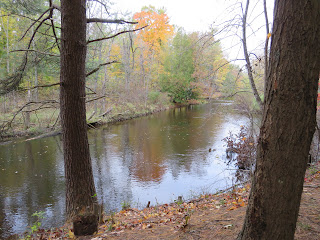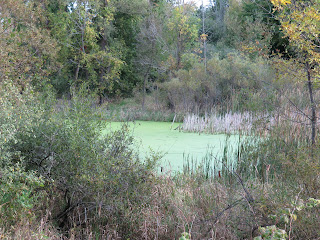Last Wednesday, I returned to Lumberjack
Park near Riverdale to check out the condition of the new
nature trail that was opened last summer. The early morning weather was partly sunny with a temperature of 37 degrees and a gusty wind out of the southwest. Leaving the car parked in the lot at the south trailhead off Madison Rd, I followed the Sugar Maple
Trail east over a blanket of fallen leaves. Turning north and then west, I entered the Mud Creek
Trail that took me down the steps and across the
boardwalk. Turning east and then north I began crossing the
bridge over Mud Creek where I paused to notice the
reflection of a cloudy blue sky on the surface. Also, while listening to a Chickadee, I spotted a Bur Oak leaf and a Sugar Maple leaf
floating underneath. As the rising sun broke through the clouds, I continued north past the creek through a
stand of mature Red and White Pine before turning west down the slope to the White Pine Trail. Following this
trail northwest through a corridor of conifers, I came to the north
trailhead off Lumberjack Rd. where I paused at the parking area and noticed some late blooming Daisy Fleabane
blossoms. As the wind picked up and leaves began to fall, I retraced my
steps a short distance southeast before veering right and following the Riverview
Trail where I came upon a strange looking, rarely-seen
fungus clinging to a tree trunk called Ruffled Paper Fungus. Continuing along a high bank above the Pine River, I paused at the Keeler bench to observe the
water flowing southeast carrying many fallen leaves. Further ahead, I stepped off the trail to the edge of the
river to look and listen. Turning east through another
stand of Red and White Pine, I noticed a few Royal
Fern fronds still retained their green color. Joining up with the Mud Creek Trail, I retraced my steps back across the bridge where I came upon some fresh, edible, 2-3 inch Dryad Saddle
mushrooms. Heading south back over the boardwalk and up the steps, I spotted some grape-size, edible Stump Puffball
mushrooms. Continuing south, I finally made it back to the
car for my trip home.
October forest
Eyes on the wild
Trail is littered
Leaves are piled
Descending the dome
One by one
Leaves of maple
Beams of sun
Up from the earth
Mushrooms appear
Just ahead
A Whitetail deer
D. DeGraaf




